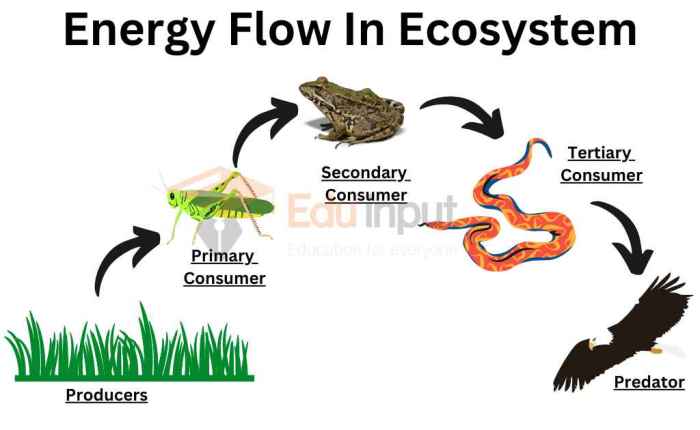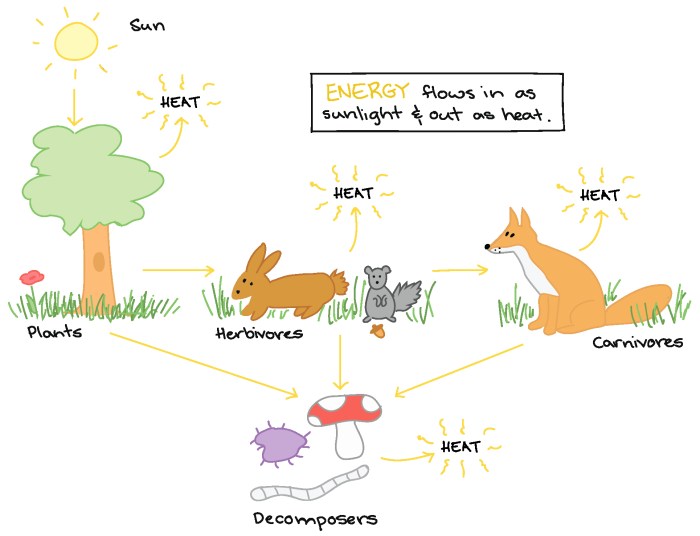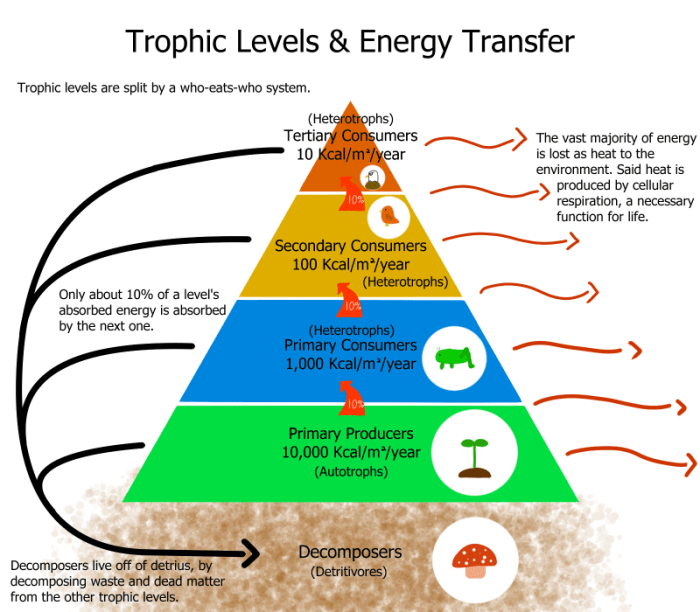Flow of energy in an ecosystem worksheet – Embark on a journey into the intricate web of energy flow within ecosystems with our comprehensive worksheet, “Flow of Energy in an Ecosystem.” Dive into the fundamental concepts, unravel the roles of producers and consumers, and explore the fascinating dynamics that shape the transfer of energy through trophic levels.
This worksheet promises an engaging and illuminating exploration into the lifeblood of our planet’s ecosystems.
Our in-depth exploration will illuminate the significance of energy flow for ecosystem functioning, untangle the complexities of food chains and food webs, and reveal the profound impact of human activities on these delicate balances. Prepare to gain a comprehensive understanding of the intricate processes that sustain the vibrant tapestry of life on Earth.
Introduction
Energy flow in an ecosystem refers to the transfer and transformation of energy within a community of living organisms and their physical surroundings. This flow of energy is crucial for ecosystem functioning, supporting various ecological processes and maintaining the stability of natural systems.
The energy that drives ecosystems primarily originates from the sun. Plants, algae, and other photosynthetic organisms capture this energy through photosynthesis, converting it into chemical energy stored in organic compounds. These organisms, known as producers, form the foundation of food chains and food webs.
Producers and Consumers
Producers are autotrophic organisms that can synthesize their own food using inorganic compounds and energy from the sun or other sources. They are the primary source of energy for all other organisms in an ecosystem.
Consumers are heterotrophic organisms that cannot produce their own food and must consume other organisms to obtain energy. Consumers can be classified into different trophic levels based on their position in the food chain.
Trophic Levels

Trophic levels represent the hierarchical arrangement of organisms within a food chain. Each level represents a group of organisms that share a similar feeding strategy and occupy a specific position in the energy flow.
The first trophic level consists of producers, followed by primary consumers (herbivores), secondary consumers (carnivores), and so on. Decomposers, such as bacteria and fungi, occupy the final trophic level, breaking down organic matter and returning nutrients to the ecosystem.
Food Chains and Food Webs

A food chain is a linear sequence of organisms through which energy flows, with each organism consuming the one below it. Food webs are more complex representations of energy flow, depicting the interconnected feeding relationships within an ecosystem.
Food chains and food webs illustrate the transfer of energy and nutrients through different trophic levels, highlighting the interdependence of species within an ecosystem.
Energy Pyramids
Energy pyramids are graphical representations that depict the amount of energy available at each trophic level within an ecosystem. They show a gradual decrease in energy as it moves up the trophic levels.
The pyramid shape illustrates the loss of energy due to inefficiencies in energy transfer between trophic levels, respiration, and other metabolic processes.
Energy Transfer Efficiency

Energy transfer efficiency refers to the proportion of energy transferred from one trophic level to the next. It is typically around 10%, meaning that only about 10% of the energy available at a given trophic level is passed on to the next higher level.
This inefficiency in energy transfer contributes to the pyramid shape of energy pyramids and limits the number of trophic levels that can be supported in an ecosystem.
Human Impact on Energy Flow: Flow Of Energy In An Ecosystem Worksheet
Human activities can significantly impact energy flow in ecosystems. Deforestation, urbanization, and pollution can disrupt the balance of energy transfer and nutrient cycling.
For example, deforestation reduces the availability of producers, which in turn affects the energy available to consumers at higher trophic levels. Similarly, pollution can alter the availability of nutrients, affecting the growth and productivity of organisms throughout the ecosystem.
Helpful Answers
What is the significance of energy flow in ecosystems?
Energy flow is the foundation of all ecosystem processes, driving nutrient cycling, maintaining biodiversity, and supporting the survival and growth of organisms.
How do producers and consumers contribute to energy flow?
Producers (plants) capture sunlight and convert it into chemical energy through photosynthesis, while consumers (animals) obtain energy by consuming other organisms.
What are trophic levels and how do they relate to energy flow?
Trophic levels represent the hierarchical feeding relationships within an ecosystem, with producers at the base and top predators at the apex. Energy flows unidirectionally from lower to higher trophic levels.
How do food chains and food webs differ?
Food chains depict simple, linear feeding relationships, while food webs represent complex, interconnected feeding networks that more accurately reflect the intricate dynamics of ecosystems.
What is energy transfer efficiency and how does it impact energy flow?
Energy transfer efficiency refers to the amount of energy transferred from one trophic level to the next. Only a small fraction of energy is typically transferred, leading to a gradual decline in energy availability at higher trophic levels.